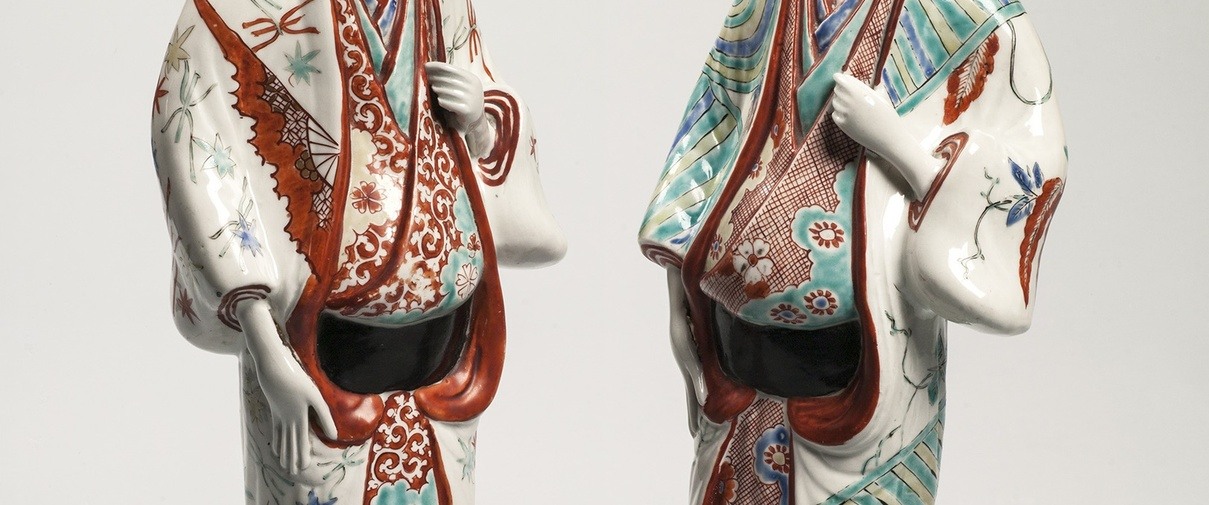Two bijin (beautiful women) figures, Japan, ca. 1670-1690, porcelain, h. 38,4 cm and 39,3 cm, acquired with support from the Rembrandt Society, Mondriaan Fund and Wassenbergh-Clarijs-Fontein Foundation.
The kimono these bijin are wearing were fashionable in the Kanbun period (1661 - 1673) and are characterised by a loose robe with a black obi (sash) around the woman’s waist. They wear their hair up in the gosho-mage style. This hairstyle was originally reserved for palace ladies, but became so popular that women outside the palace adopted it too.
The type of porcelain used to make these figures and the way they are decorated are known as Kakiemon, a production technique that was developed in the mid-seventeenth century. The Kakiemon potters established their workshop near Arita on the island of Kyushu and used the finest white clay to make their wares. This tradition has survived until today: Kakiemon XV is currently active and is regarded as one of the ‘Living National Treasures’ of Japan.
These two bijin figures were formed in a mould. They have identical shapes, but different colours and patterns have been used for their kimono, based on actual kimono from that time. This makes each figure unique. In combination with the refined brushwork, this explains why such figures were so highly prized in both Japan and Europe. Figures from Japan and China became increasingly popular in Europe at the end of the seventeenth century. They were an important showpiece in porcelain rooms or functioned as table decorations during dinners. There was even a real craze for porcelain figurines. This eventually led to the local production of figures of, for example, dancers and amorous couples, of which the Meissen figurines are the best known.
East and West
There is a seal on the bases of both figures reading ‘O. du Sartel’ and the number 424. These data can be traced back to April 1882. There was an auction that month at Hotel Drouot in Paris of Chinese and Japanese porcelain from the collection of Octave du Sartel (1823 - 1849). Sartel was a naval officer as well as a member of the Manufacture de Sèvres porcelain factory development committee. In the catalogue of the auction Catalogue des Porcelaines de la Chine et du Japon, composant du collection M.O. du Sartel, Parijs, 1882 (The Catalogue of Chinese and Japanese Porcelain, Comprising the Collection of M.O. du Sartel, Paris, 1882), the figures are listed under Japanese porcelain as lot 424: Deux Statuettes de femmes, en même porcelaine, dont les vêtements sont richement décorés en rouge de fer et émaux verts et bleu pâle. (‘Two statuettes of women, of the same porcelain, whose clothes are richly decorated in iron red and green and pale blue enamels’).
The highest bidder was probably a man from a European noble family who was an ambassador to the Far East. In 2009, this family also auctioned off the figures, and an Asian art dealer from New York purchased them. It was through this dealer that the beautiful Kakiemon bijin eventually ended up in the Princessehof, where these two elegant courtesans contribute to the story of the interaction between East and West.
Eline van den Berg, curator of Asian ceramics at the Princessehof National Museum of Ceramics.
